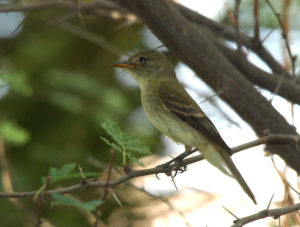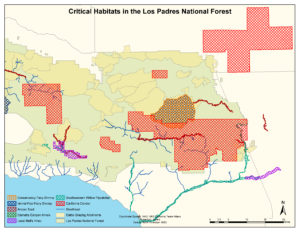Empidonax traillii extimus
- Endangered – Endangered Species Act (1995)

Southwestern willow flycatcher. Photo by Jim Rorabaugh/USFWS.
Description
The southwestern willow flycatcher — a subspecies of the willow flycatcher — is a small songbird, up to 6 inches in length. It is mainly recognized by its distinct “fitz-bew” call, and the flycatcher’s songs are innate as opposed to learned, which is a unique characteristic that differentiates it from other songbirds. Their particular songs are how biologists and researchers tell flycatcher species apart! Listed as endangered under the Endangered Species Act in 1995, the southwestern flycatcher is an important indicator of the health of the unique landscape it calls home.
Habitat and Food
The flycatcher is found in brushy fields, shrubs, and thick woodland areas often located along the edge of streams or marshes. Their habitat is essential to their feeding behavior because they forage from their perch within shrubs or trees and fly out to catch insects. They employ the “sit and wait strategy” to catch their prey, often perching atop branches until they locate their target and quickly fly out to snatch it. Known as the “master of gnats,” the flycatcher’s diet consists mainly of small insects such as bees, beetles, and caterpillars, but they have also been known to consume some spiders and a few types of berries.
Distribution
The southwestern willow flycatcher’s habitat and breeding range includes southern California, Arizona, New Mexico, southern portions of Nevada and Utah, western Texas, southwestern Colorado, and northwestern Mexico. In the Los Padres National Forest, they can be found particularly in the Mono and Indian Creek Watersheds of the San Rafael Mountains. This area, referred to as the Mono Basin Special Interest Area by the USFS, is home to one of the largest cottonwood/willow riparian woodlands in southern California. Because of this unique feature, the Mono Basin supports more than 100 breeding or migrating bird species including the southwestern willow flycatcher. They can also be found in areas along Matilija Creek, Piru Creek, and the Upper Santa Ynez River.
Reproduction and Nesting
This willow flycatcher breeds in late spring after returning from wintering grounds in Latin America. Males court females by chasing their desired partner throughout the trees until the male finally wins his selected female over. After pairing up, females build small nests above the ground to lay their eggs in. Brownheaded cowbirds have also been known to lay their eggs in the nests that female southwestern willow flycatchers build for their young, in which case the bird may bury the cowbird eggs in the nest lining or build a completely new nest on top of the old one!
Challenges and Conservation Efforts
Due to habitat loss and fragmentation primarily caused by water diversion, groundwater pumping and the spread of invasive species, the southwestern willow flycatcher’s numbers have heavily declined. Additional threats include livestock grazing and cowbird parasitism. However, the addition of the southwestern willow flycatcher to the list of endangered species has helped focus efforts to conserve its habitat. Common conservation tactics include restoration projects and the removal of invasive trees such as Russian olives or tamarisk (saltcedar) in riparian areas.
In 2013 critical habitat areas for the southwestern willow flycatcher were designated in the Los Padres National Forest by the US Fish & Wildlife Service (FWS). These include portions of Matilija Creek, Piru Creek, the Upper Santa Ynez River, and lower Mono Creek. The critical habitat designations greatly restrict damaging activities in these areas.

Critical habitat designations for multiple species, including the southwestern willow flycatcher. Click to expand.
However, challenges remain for the recovery of the southwestern willow flycatcher. In 2016 the FWS announced that it would consider a request submitted on behalf of the building industry as well as farming and grazing interests to remove the southwestern willow flycatcher from the list of endangered species. This petition to delist the southwestern willow flycatcher is based on an argument that the species is not a distinct subspecies of the more common willow flycatcher, a bird that is not on the list of endangered species. In 2015, the FWS issued a finding stating that the delisting “may be warranted,” and they requested further information and research from the public and independent scientists. A study in 2016 concluded that the plumage and song of the southwestern willow flycatcher is distinct enough to warrant protection under the Endangered Species Act. However, the FWS has not issued a final decision. ForestWatch will continue to monitor this issue and fight to ensure this unique species is fully protected.






